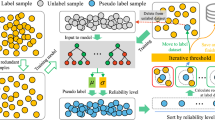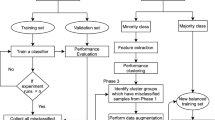Abstract
Imbalanced datasets are usually a challenge on classification tasks, especially in the manufacturing industry. These skewed class distributions bring out the poor performance in traditional machine learning algorithms. In addition, most of the collected datasets contain noises that make the analysis process even harder. The noises could be the missing data or irrelevant variables in the datasets. Dealing with these noisy datasets remains an important step in data analysis. For these two reasons, we propose a Gradient Deep Learning Boosting (GDLB) model to deal with imbalanced datasets containing noises in the classification task. In dealing with noise, we use the Imputation transformer for handling the missing data and deployed the Random forest method for features selection. The two benchmark datasets named SECOM and DAIWM are implemented to prove our proposed method’s performance. Those are particular imbalance datasets containing noise. Our proposed method had an accuracy, recall, Matthews correlation coefficient, and Area under the curve of 0.87, 0.70, 0.32, and 0.79, respectively on the SECOM dataset. On the other hand, on the DAIWM dataset, our proposed method achieves 0.91, 0.83, 0.56, and 0.87 respectively. We found that the combination of proposed Gradient Deep Learning Boosting and handling noises is a prospective model for imbalanced datasets.
Access this chapter
Tax calculation will be finalised at checkout
Purchases are for personal use only
Similar content being viewed by others
References
Dang, T.K., et al.: Future Data and Security Engineering: 4th International Conference, FDSE 2017, Ho Chi Minh City, Vietnam, November 29–December 1, 2017, Proceedings, vol. 10646. Springer (2017)
Nedelcu, B.: About Big Data and its challenges and benefits in manufacturing. Database Syst. J. 4(3), 10–19 (2013)
Wheelwright, S.C., Bowen, H.K.: The challenge of manufacturing advantage. Prod. Oper. Manag. 5(1), 59–77 (1996)
Ren, S., et al.: A comprehensive review of big data analytics throughout product lifecycle to support sustainable smart manufacturing: a framework, challenges and future research directions. J. Clean. Prod. 210, 1343–1365 (2019)
Zhao, Z.-Q., et al.: Object detection with deep learning: a review. IEEE Trans. Neural Netw. Learn. Syst. 30(11), 3212–3232 (2019)
Nguyen, T.-T.-D., Nguyen,D.-K., Ou, Y.-Y.: Addressing data imbalance problems in ligand-binding site prediction using a variational autoencoder and a convolutional neural network. Brief. Bioinform. 22(6), bbab277 (2021)
Korotcov, A., et al.: Comparison of deep learning with multiple machine learning methods and metrics using diverse drug discovery data sets. Mol. Pharm. 14(12), 4462–4475 (2017)
Miotto, R., et al.: Deep learning for healthcare: review, opportunities and challenges. Brief. Bioinform. 19(6), 1236–1246 (2018)
Köse, T., et al.: Effect of missing data imputation on deep learning prediction performance for vesicoureteral reflux and recurrent urinary tract infection clinical study. BioMed Res. Int. 2020 (2020)
Bengio, Y., Courville, A.C., Vincent, P.: Unsupervised feature learning and deep learning: a review and new perspectives. CoRR, abs/1206.5538 1, 2012 (2012)
Allison, P.: Missing Data, vol. 136. Sage Publications, Thousand Oaks (2001)
Sessa, J., Syed, D.: Techniques to deal with missing data. in 2016 5th international conference on electronic devices, systems and applications (ICEDSA). IEEE (2016)
John, G.H., Kohavi, R., Pfleger, K.: Irrelevant features and the subset selection problem, in Machine learning proceedings 1994, pp. 121–129. Elsevier (1994)
Li, J., et al.: Feature selection: a data perspective. ACM Comput. Surv. (CSUR) 50(6), 1–45 (2017)
Chandrashekar, G., Sahin, F.: A survey on feature selection methods. Comput. Electr. Eng. 40(1), 16–28 (2014)
Sun, Y., Wong, A.K., Kamel, M.S.: Classification of imbalanced data: a review. Int. J. Pattern Recognit. Artif. Intell. 23(04), 687–719 (2009)
López, V., et al.: An insight into classification with imbalanced data: empirical results and current trends on using data intrinsic characteristics. Inf. Sci. 250, 113–141 (2013)
Fathy, Y., Jaber, M., Brintrup, A.: Learning with imbalanced data in smart manufacturing: a comparative analysis. IEEE Access 9, 2734–2757 (2021)
Koziarski, M., Krawczyk, B., Woźniak, M.: Radial-Based oversampling for noisy imbalanced data classification. Neurocomputing 343, 19–33 (2019)
Haixiang, G., et al.: Learning from class-imbalanced data: review of methods and applications. Expert Syst. Appl. 73, 220–239 (2017)
Kim, J., Han, Y., Lee, J.: Data imbalance problem solving for smote based oversampling: study on fault detection prediction model in semiconductor manufacturing process. Adv. Sci. Technol. Lett. 133, 79–84 (2016)
Moldovan, D., et al.: Chicken swarm optimization and deep learning for manufacturing processes. In: 2018 17th RoEduNet conference: networking in education and research (RoEduNet). IEEE (2018)
Tseng, J., Motoda, L.C.H., Xu, G.: Advances in knowledge discovery and data mining. In: Lecture Notes in Artificial Intelligence (2003)
Nguyen, D.-K., Lan, C.-H., Chan, C.-L.: Deep ensemble learning approaches in healthcare to enhance the prediction and diagnosing performance: the workflows, deployments, and surveys on the statistical, image-based, and sequential datasets. Int. J. Environ. Res. Public Health 18(20), 10811 (2021)
Nguyen, D.-K., et al.: Deep Stacked Generalization Ensemble Learning models in early diagnosis of depression illness from wearable devices data. In: Proceedings of the 5th International Conference on Medical and Health Informatics (ICMHI 2021), Kyoto, Japan (2021)
Jia, F., et al.: Deep neural network ensemble for the intelligent fault diagnosis of machines under imbalanced data. IEEE Access 8, 120974–120982 (2020)
machinehack: Detecting anomalies in wafer manufacturing: Weekend Hackathon #18, machinehack, Editor. Machinehack (2020)
Dua, D., Graff, C.: UCI Machine Learning Repository (2017)
Anaconda Software Distribution. Anaconda Documentation (2020)
Abadi, M., et al.: Tensorflow: A system for large-scale machine learning. In: 12th ${$USENIX$}$ Symposium on Operating Systems Design and Implementation (${$OSDI$}$ 16), pp. 265–283 (2016)
Pedregosa, F., et al., Scikit-learn: Machine learning in Python. Journal of machine learning research, 2011. 12(Oct): p. 2825–2830.
Bach, M., Werner, A.: Cost-Sensitive Feature Selection for Class Imbalance Problem. Springer International Publishing, Cham (2018)
Liu, F., et al.: A New fuzzy spiking neural network based on neuronal contribution degree. IEEE Trans. Fuzzy Syst. (2021)
Acknowledgements
This study is funded by Ministry of Science and Technology, Taiwan, grant number MOST 108-2221-E-155-019-MY3.
Author information
Authors and Affiliations
Corresponding author
Editor information
Editors and Affiliations
Rights and permissions
Copyright information
© 2023 The Author(s), under exclusive license to Springer Nature Switzerland AG
About this paper
Cite this paper
Nguyen, DK., Chan, CL., Phan, DV. (2023). Gradient Deep Learning Boosting and Its Application on the Imbalanced Datasets Containing Noises in Manufacturing. In: Tsihrintzis, G.A., Wang, SJ., Lin, IC. (eds) 2021 International Conference on Security and Information Technologies with AI, Internet Computing and Big-data Applications. Smart Innovation, Systems and Technologies, vol 314. Springer, Cham. https://doi.org/10.1007/978-3-031-05491-4_23
Download citation
DOI: https://doi.org/10.1007/978-3-031-05491-4_23
Published:
Publisher Name: Springer, Cham
Print ISBN: 978-3-031-05490-7
Online ISBN: 978-3-031-05491-4
eBook Packages: Intelligent Technologies and RoboticsIntelligent Technologies and Robotics (R0)




